I haven't provided detailed commentary on the US labour market for a while now. To…
Australian labour market – stagnating
Today’s release of the – Labour Force data – for November 2013 by the Australian Bureau of Statistics confirms that the new government needs to substantially alter the macroeconomic policy settings in favour of stimulus to address the virtually zero employment growth and the upward trend in unemployment. We learned today that employment growth failed to keep pace with the underlying population growth and as a result unemployment rose to 5.8 per cent (with participation constant). Hours of work also fell. The actual extent of labour underutilisation is significantly higher than indicated by the unemployment rate, given that the participation rate is well down on its most recent peak and underemployment is at 7.6 per cent. With the new government biased towards “market outcomes” the current austerity mindset will ensure the labour market deteriorates further.
The summary ABS Labour Force (seasonally adjusted) estimates for November 2013 are:
- Employment increased 21,000 (0.8 per cent) with full-time employment rising by 15,500 and part-time employment rising by 5,500.
- Unemployment increased by 3,400 (0.5 per cent) to 712,500.
- The official unemployment rate rose (due to rounding) to 5.8 per cent (from 5.7 per cent).
- The participation rate was constant at 64.8 per cent and is still well below its November 2010 peak (recent) of 65.9 per cent.
- Aggregate monthly hours worked increased by 11.7 million hours (0.7 per cent).
- The quarterly ABS broad labour underutilisation estimate (the sum of unemployment and underemployment) were published this month for the November-quarter and showed that underemployment fell by 0.2 percentage points to 7.6 per cent. The total labour underutilisation rate fell from 13.7 per cent in the August-quarter to 13.4 per cent in November. There were 941 thousand persons underemployed. Overall, there are 1.7 million workers either unemployed or underemployed.
Employment growth – continues to be fluctuate around zero
The November 2013 data shows that employment increased by 21,000 (0.8 per cent) with full-time employment rising by 15,500 and part-time employment rising by 5,500.
Over the last 24 months or so we have seen the labour market data switching back and forth regularly between negative employment growth and positive growth spikes.
This pattern has consolidated and indicates the current policy settings are wrong and a stimulus is required.
There have been considerable fluctuations in the full-time/part-time growth over the last year with regular crossings of the zero growth line.
The following graph shows the month by month growth in full-time (blue columns), part-time (grey columns) and total employment (green line) for the 12 months to November 2013 using seasonally adjusted data.
Today’s results just repeat the topsy-turvy nature of the data over the period shown.
While full-time and part-time employment growth are fluctuating around the zero line, total employment growth is still well below the growth that was boosted by the fiscal-stimulus in the middle of 2010.
The following table provides an accounting summary of the labour market performance over the last six months. The monthly data is highly variable so this Table provides a longer view which allows for a better assessment of the trends. WAP is working age population (above 15 year olds).
The conclusion – overall there have only been 10.5 thousand jobs (net) lost in Australia over the last six month, which is appalling.
Over the last six months, full-time employment has fallen by 35.9 thousand jobs (net) while part-time work has risen by 46.4 thousand jobs.
The Working Age Population has risen by 164 thousand in the same period while the labour force has risen by just 36.3 thousand. The labour force growth is tepid (relative to the growth in the WAP) because participation has fallen substantially (0.371 percentage points).
This has had the effect of attenuating the rise in unemployment.
The weak employment growth has thus not been able to keep pace with the underlying population growth and unemployment has risen by 26 thousand as a result.
The rise in unemployment would have been much worse had the participation rate not dropped.
To put the recent data in perspective, the following graph shows the movement in the labour force and total employment since the low-point unemployment rate month in the last cycle (February 2008) to November 2013. The two series are indexed to 100 at that month. The green line (right-axis) is the gap (plotted against the right-axis) between the two aggregates and measures the change in the unemployment rate since the low-point of the last cycle (when it stood at 4 per cent).
You can see that the labour force index has largely levelled off and now falling and the divergence between it and employment growth has been relatively steady over the last several months with this month showing some improvement.
The Gap series gives you a good impression of the asymmetry in unemployment rate responses even when the economy experiences a mild downturn (such as the case in Australia). The unemployment rate jumps quickly but declines slowly.
It also highlights the fact that the recovery is still not strong enough to bring the unemployment rate back down to its pre-crisis low. You can see clearly that the unemployment rate fell in late 2009 and then has hovered at the same level for some months before rising again over the last several months.
The Gap shows that the labour market is still a long way from recovering from the financial crisis that hit in early 2008. There hasn’t been much progress since January 2010, when the fiscal stimulus started to run out.
In fact, in November 2013, the Gap (2.1 percentage points) exceeded the levels that appeared in May and June 2009 when the Australian economy was enduring the impact of the crisis. All the gains made since then have thus disappeared due to poorly crafted fiscal policy not responding appropriately to non-government spending changes.
Full-time and Part-time employment in recovery
The following graph shows employment indexes for the last 3 recessions and allows us to see how the trajectory of total employment after each peak prior to the three major recessions in recent history: 1982, 1991 and 2009 (the latter to capture the current episode). The peak is defined as the month of the low-point unemployment rate in the relevant cycle and total employment was indexed at 100 in each case and then indexed to that base for each of the months as the recession unfolded.
I have plotted the 3 episodes for 69 months after the low-point unemployment rate was reached in each cycle. The current episode is now in its 69th month.
The initial employment decline was similar for the 1982 and 1991 recessions but the 1991 recovery was delayed by many month and the return to growth much slower than the 1982 recession.
The current episode is distinguished by the lack of a major slump in total employment, which reflects the success of the large fiscal stimulus in 2008 and 2009.
However, the recovery spawned by the stimulus clearly dissipated once the fiscal position was reversed and the economy is now producing very subdued employment outcomes.
Moreover, the current episode is also different to the last two major recessions in the sense that the recovery is over and the economy is deteriorating again.
The next 3-panel graph decomposes the previous graph into full-time and part-time employment. The vertical scales are common to allow a comparison between the three episodes.
First, after the peak is reached, part-time employment continues to increase as firms convert full-time jobs into fractional jobs.
Second, recoveries are dominated by growth in part-time employment as firms are reluctant to commit to more permanent arrangements with workers while there is uncertainty of the future course in aggregate demand.
Third, the current recovery is clearly mediocre by comparison, with both subdued growth in full-time and part-time work.
Teenage labour market – continues to deteriorate
Full-time employment for teenagers fell by 0.1 thousand in November 2013 while part-time employment fell by 5.7 thousand. Overall, teenage employment fell by 5.9 thousand (net) jobs.
The following graph shows the distribution of net employment creation in the last month by full-time/part-time status and age/gender category (15-19 year olds and the rest)
If you take a longer view you see how poor the situation is.
Over the last 12 months, teenagers have lost 21.4 thousand jobs while the rest of the labour force have gained 109.2 thousand net jobs. Remember that the overall result represents a very poor annual growth in employment.
Even more disturbing is the attrition of full-time jobs among teenagers – losing 33.3 thousand over the last year.
The teenage segment of the labour market is being particularly dragged down by the sluggish employment growth, which is hardly surprising given that the least experienced and/or most disadvantaged (those with disabilities etc) are rationed to the back of the queue by the employers.
The following graph shows the change in aggregates over the last 12 months.
To further emphasise the plight of our teenagers, I compiled the following graph that extends the time period from the February 2008, which was the month when the unemployment rate was at its low point in the last cycle, to the present month (November 2013). So it includes the period of downturn and then the so-called “recovery” period. Note the change in vertical scale compared to the previous two graphs.
Since February 2008, there have been only 862.1 thousand (net) jobs added to the Australian economy but teenagers have lost a staggering 114.5 thousand over the same period. It is even more stark when you consider that 109.8 thousand full-time teenager jobs have been lost in net terms.
Even in the traditionally, concentrated teenage segment – part-time employment – 4.7 thousand jobs (net) have been lost even though some 499 thousand part-time jobs have been added overall.
Overall, the total employment increase is modest. Further, around 57.8 per cent of the total (net) jobs added since February 2008 have been part-time, which raises questions about the quality of work that is being generated overall.
To put the teenage employment situation in a scale context the following graph shows the Employment-Population ratios for males, females and total 15-19 year olds since February 2008 (the month which coincided with the low-point unemployment rate of the last cycle).
You can interpret this graph as depicting the loss of employment relative to the underlying population of each cohort. We would expect (at least) that this ratio should be constant if not rising somewhat (depending on school participation rates).
The facts are that the absolute loss of jobs reported above is depicting a disastrous situation for our teenagers. Males, in particular, have lost out severely as a result of the economy being deliberately stifled by austerity policy positions.
Overall, the performance of the teenage labour market is close to disastrous. It doesn’t rate much priority in the policy debate, which is surprising given that this is our future workforce in an ageing population. Future productivity growth will determine whether the ageing population enjoys a higher standard of living than now or goes backwards.
The longer-run consequences of this teenage “lock out” will be very damaging.
The problem is that in the modest growth period that the Australian labour market enjoyed as a result of the fiscal stimulus and mining investment, teenagers failed to participate in the gains – they went backwards.
Now, with the economy entering a new period of slowdown, these losses will be added too given that teenagers are among the first in line to be shown the door by employers seeking to reduce staff levels in the face of declining aggregate sales.
The previous Government’s response was to push this cohort into endless training initiatives (supply-side approach) without significant benefits. The research shows overwhelmingly that job-specific skills development should be done within a paid-work environment.
I would recommend that the new Australian government immediately announce a major public sector job creation program aimed at employing all the unemployed 15-19 year olds, who are not in full-time education or a credible apprenticeship program.
It is clear that the Australian labour market continues to fail our 15-19 year olds. At a time when we keep emphasising the future challenges facing the nation in terms of an ageing population and rising dependency ratios the economy still fails to provide enough work (and on-the-job experience) for our teenagers who are our future workforce.
Unemployment
The unemployment rate increased to 5.8 per cent in November 2013, up from 5.7 per cent in October. Official unemployment increased by 3,400 (0.5 per cent) to 712,500.
Overall, the labour market still has significant excess capacity available in most areas and what growth there is is not making any major inroads into the idle pools of labour.
The following graph updates my 3-recessions graph which depicts how quickly the unemployment rose in Australia during each of the three major recessions in recent history: 1982, 1991 and 2009 (the latter to capture the 2008-2010 episode). The unemployment rate was indexed at 100 at its lowest rate before the recession in each case (January 1981; January 1989; April 2008, respectively) and then indexed to that base for each of the months as the recession unfolded.
I have plotted the 3 episodes for 69 months after the low-point unemployment rate was reached in each cycle. The current episode is now in its 69th month (0 being February 2008). For 1991, the peak unemployment which was achieved some 38 months after the downturn began and the resulting recovery was painfully slow. While the 1982 recession was severe the economy and the labour market was recovering by the 26th month. The pace of recovery for the 1982 once it began was faster than the recovery in the current period.
It is significant that the current situation while significantly less severe than the previous recessions is dragging on which is a reflection of the lack of private spending growth and declining public spending growth.
Moreover, the current episode is also different to the last two major recessions in the sense that the recovery is over and the economy is deteriorating again.
The graph provides a graphical depiction of the speed at which the recession unfolded (which tells you something about each episode) and the length of time that the labour market deteriorated (expressed in terms of the unemployment rate).
From the start of the downturn to the 69-month point (to November 2013), the official unemployment rate has risen from a base index value of 100 to a value 146.2 – peaking at 148 after 17 months. After falling steadily as the fiscal stimulus pushed growth along (it reached 122.8 after 35 months – in January 2010), it has been slowly trending up for some months now. Unlike the other episodes, the current trend, at this stage of the cycle, is upwards.
It will soon be above the peak that was reached just before the introduction of the fiscal stimulus. In other words, the gains that emerged in the recovery as a result of the fiscal stimulus in 2009-10 have now been lost.
At 69 months, 1982 index stood at 157.2 while the 1991 index was at 143.8. It is clear that at an equivalent point in the “recovery cycle” the current period is more sluggish than our recent two major downturns and trending upwards while the trend in the earlier episodes was moderately downwards.
It now appears that the recoveries are converging, which tells us that the current policy has failed to take advantage of the fact that the latest economic downturn was much more mild than the previous recessions. In other words, the policy failure is locking the economy into a higher unemployment rate than is desirable and otherwise attainable.
Note that these are index numbers and only tell us about the speed of decay rather than levels of unemployment. Clearly the 5.7 per cent at this stage of the downturn is lower that the unemployment rate was in the previous recessions at a comparable point in the cycle although we have to consider the broader measures of labour underutilisation (which include underemployment) before we draw any clear conclusions.
The notable aspect of the current situation is that the recovery is very slow.
Broader labour underutilisation
The ABS published its quarterly broad labour underutilisation measures in this data release.
In the November-quarterly, total underemployment fell by 0.2 percentage points to 7.6 per cent and the ABS broad labour underutilisation rate fell by 0.3 points to 13.4 per cent (the sum of unemployment and underemployment).
| There were 941 thousand persons underemployed. Overall, there are 1.7 million workers either unemployed or underemployed. |
The following graph plots the history of underemployment in Australia since February 1978.
If hidden unemployment is added to the broad ABS figure the best-case (conservative) scenario would see a underutilisation rate well above 15 per cent at present. Please read my blog – Australian labour underutilisation rate is at least 13.4 per cent – for more discussion on this point.<
The following graph shows the same type of indexes as the previous graph except it uses the ABS broad labour underutilisation rate (unemployment plus underemployment). It also is in terms of quarters rather than months.
We also show the full evolution of the the 1982 and 1991 episodes from the low-point (= 100) through the peak and back to the next low-point. In the case of the 1982 recession the index had risen to a peak of 172.8 in May 1983 (a broad underutilisation rate of 14.4 per cent) and then fell back to 9.8 per cent by November 1989 (index value 117.4).
At that point, the cycle turned down again signalling the beginning of the 1991 recession. That cycle reached a peak of 185 (or 18.1 per cent in November 1992) and it took until February 2008 for it to reach the low-point of 9.9 percent (an index value of 100.9). That point marked the beginning of the next cycle.
That should tell you how severe the 1991 recession was and how asymmetric the labour market response is on either side of the cycle. From its start in November 1989 it took 74 quarters (18.5 years) to return to more or less that level.
In terms of the three recession comparison, at the same period in the recovery (using quarterly data), the broad labour underutilisation rate (unemployment plus underemployment) had an index value of 144.1 in the 1982 recession (absolute value of 12 per cent); an index value of 154.4 in the 1991 recession (absolute value of 15.1 per cent); and an index value of 135.6 in the current period (absolute value of 13.4 per cent).
So while the level of unemployment is much lower now than in the 1982 recession (at a comparable stage), underemployment is now much higher and so the total labour underutilisation rates is higher. Further, the 1982 recovery in broad underutilisation terms was more robust than the current stagnating situation.
Commentators who think of the 1982 recession as severe, rarely see it in these terms. Joblessness is probably worse than underemployment but both mean that labour is wasted and income earning opportunities are being foregone. For a worker with extensive nominal commitments, the loss of income when hours are rationed may be no less severe than the loss of hours involved in unemployment, if the threshold of solvency is breached.
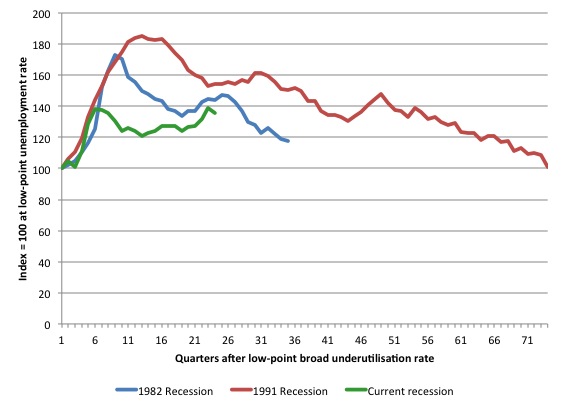
Aggregate participation rate constant
The ABS revised the October participation rate down to 64.8 per cent (from 64.9 per cent). In the current month, participation was constant at that new revised figure of 64.8 per cent.
There is considerable monthly fluctuation in the participation rate but the current rate of 64.8 per cent is a long way below its most recent peak in November 2010 of 65.9 per cent.
What would the unemployment rate be if the participation rate was at that recent peak level (65.9 per cent)?
The following graph tells us what would have happened if the participation rate had been constant over the period November 2010 to November 2013. The blue line is the official unemployment since its most recent low-point of 4 per cent in February 2008.
The red line starts at November 2010 (the peak participation month). It is computed by adding the workers that left the labour force as employment growth faltered (and the participation rate fell) back into the labour force and assuming they would have been unemployed. At present, this cohort is likely to comprise a component of the hidden unemployed (or discouraged workers).
Total official unemployment in November 2013 was estimated to be 712.5 thousand. However, if participation had not have fallen there would be 930.6 thousand workers unemployed given growth in population and employment since November 2010.
| The unemployment rate would now be 7.4 per cent if the participation had not fallen below its November 2010 peak of 65.9 per cent. |
The difference between the two numbers mostly reflects the change in hidden unemployment (discouraged workers) since November 2010. These workers would take a job immediately if offered one but have given up looking because there are not enough jobs and as a consequence the ABS classifies them as being Not in the Labour Force.
Note, the gap between the blue and red lines doesn’t sum to total hidden unemployment unless November 2010 was a full employment peak, which it clearly was not. The interpretation of the gap is that it shows the extra hidden unemployed since that time.
As the participation rate dropped over the period, the gap rose.
This is quite a different picture to that portrayed by the official summary statistics.
Hours worked – fall in November 2013
Aggregate monthly hours worked fell by 11.7 million hours (0.7 per cent) in seasonally adjusted terms. The fall in hours worked this month continues the trends over several months of growth being interspersed with contraction with the trend switching back and forth between positive and negative.
The following graph shows the trend and seasonally adjusted aggregate hours worked indexed to 100 at the peak in February 2008 (which was the low-point unemployment rate in the previous cycle). The rising trend which marked the early recovery courtesy of the fiscal stimulus is now clearly gone.
The next graph shows the monthly growth (in per cent) over the last 24 months. The dark linear line is a simple regression trend – which depicts a declining trend. You can see the pattern in working hours that is also portrayed in the employment graph – zig-zagging across the zero growth line.
The data supports the conclusion that the Australian labour market is performing badly and the current policy setting are not supporting growth. There needs to be a change in policy towards stimulus. Two years with no discernible upward trend is evidence of policy failure.
Conclusion
In general, we always have to be careful interpreting month to month movements given the way the Labour Force Survey is constructed and implemented.
Overall, today’s data shows that the Australian labour market remains stuck in a stagnant state with employment growth continuing to lag behind population growth.
Despite the monthly variations we need to be cautious about, we have now had more than two years of weak-to-zero employment growth and deteriorating or suppressed participation. It is clear that the consistently weak employment growth relative to the underlying population growth is slowly but surely pushing the unemployment rate upwards.
The of labour wastage is now at least 13.4 per cent. Add to this the impacts of the falling participation rate over the last two years and the figure is well above 15 per cent.
The most striking aspect of a sad picture remains the appalling performance of the teenage labour market. Employment has collapsed for that cohort since 2008. I consider it a matter of policy urgency for the Government to introduce an employment guarantee to ensure we do not continue undermining our potential workforce.
The data certainly shows that the new government has to reverse the contractionary bias and that means only one thing – more fiscal stimulus is definitely needed.
It is time for the conservatives to abandon their free market/anti-government biases and do some public sector job creation, which will arrest the current decline and stimulate private sector activity and employment!
That is enough for today!
(c) Copyright 2013 Bill Mitchell. All Rights Reserved.
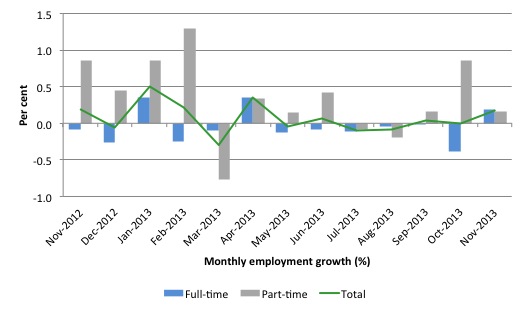
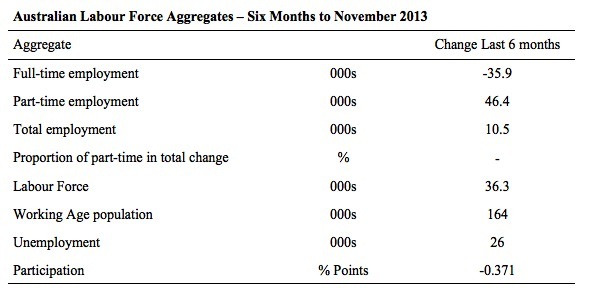
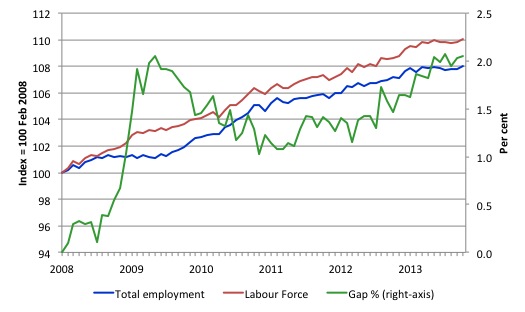
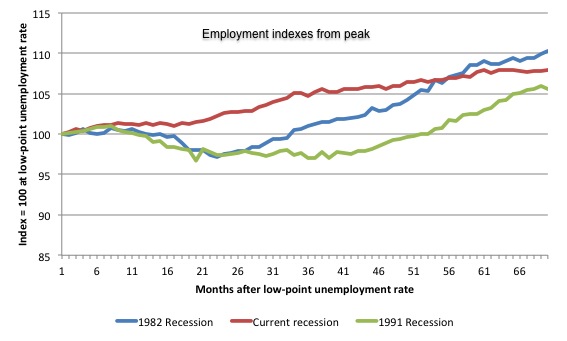

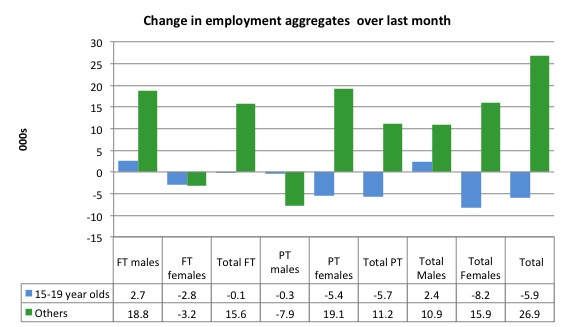
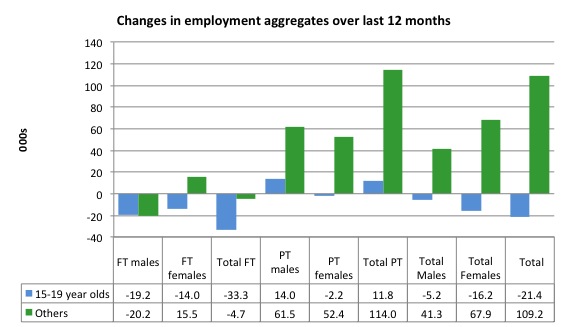
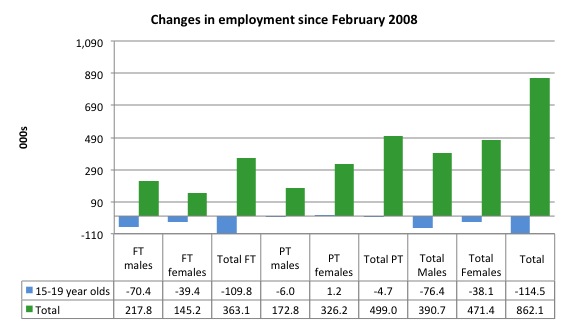

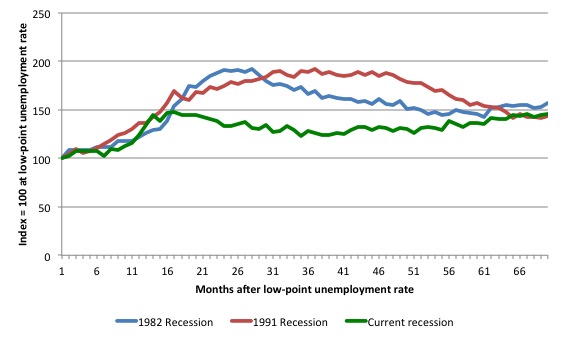

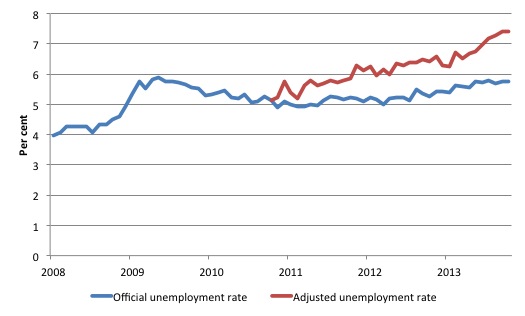
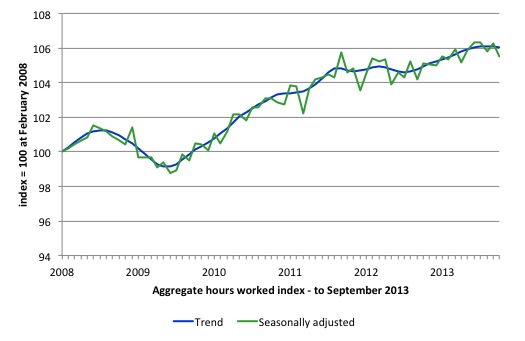
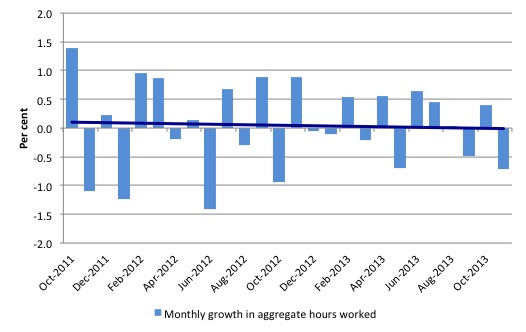
Bill, Re your call in your conclusion for more fiscal
stimulus, the obvious objection is that inflation is already at or
near the government’s 2-3% target. And it’s not just the
conservative minded who will raise that objection: MMTers are
always pointing out (correctly) that the only thing obstructing
higher deficits is inflation. So why is there any inflation at all
in Australia? I suggest the answer lies with trade unions.
According to the link below, public sector unions in Australia are
demanding and getting 3-4% pay increases over the next few years:
despite the oversupply of labour, i.e. excess unemployment. So if
productivity is rising at say 1%pa, and assuming all other
employees keep up with public sector pay increases, there will be
2-3% inflation no matter how high unemployment goes.
http://www.canberratimes.com.au/act-news/public-servants-pay-rise-approved-20130828-2sqg3.html
The pseudo socialists who run trade unions need to have it drilled
into their thick heads that the size of the wage increase that a
country’s workforce gets has NO EFFECT WHATEVER on the workforce’s
real standard of living. Also, the conservative minded politicians
and bureaucrats in the Treasury need to be persuaded that given a
rise in fiscal stimulus, there won’t be any effect on inflation, as
long as pay increases stay at the current 3-4% level. As Britain’s
former prime minister, Harold Wilson put it, “One man’s pay
increase is another man’s redundancy.”
Ralph,
the vast majority of Australia’s public servants do not reside in the ACT. The ACT is a tiny piece of land probably smaller than Luxembourg (not sure of the exact size) and contains only one significant-sized population centre, which is of course Canberra itself – a mid-sized city which is dwarfed by most of our state capitols. The bulk of Australia’s public sector workers are employed by the state governments and as one of them, I can assure you that my pay rises have amounted to about two-fifths of f**k all.
The wages fund became redundant when the classicals jettisoned the Malthusian Population Doctrine.
Someone must have forgotten to tell Harold Wilson.
With respect to inflation I’d be looking at the rise in cost of gas, electricity, petrol, oil, housing, food… and so on rather than the wage claims by unionised workers.
With respect to productivity the lions share of the gains have gone to the capitalist not the worker over the last 30 years or so.
Interesting how the profits / rents of the leisure class don’t factor into Ralphs assumptions.
“With respect to inflation I’d be looking at the rise in cost of gas, electricity, petrol, oil, housing, food… and so on rather than the wage claims by unionised workers.
With respect to productivity the lions share of the gains have gone to the capitalist not the worker over the last 30 years or so.”
Good call Alan.
And yet, a rise in productivity with a decrease of labour hours and skill required to achieve that level of productive output is almost constantly accelerating since the early 1800’s without EVER Slowing down, yet few give much thought to what happens to the private sector when this exponential rise in automation causes them to provide excessive goods and services to an oversaturated market with VERY few labour hours, to a population with many hours and skill/knowledge sets to offer (and as bill and Neil often point out, people have some NEED to use their bodies, minds and time for a purpose which is somewhat meaningful). Any meaningful political/economic/social ideal needs to offer a solution to this painfully obvious reality, or it simply doesn’t deserve to sit at the table of rational discuss.
Why are wage increases always blamed for causing inflation and yet profit increases are never blamed for causing inflation? It’s a thought-provoking question which illustrates the bias in our current economic debate. Biased media analysts support the rights of capitalists and rentiers over and against the rights of workers. Biased analysts ignore the effect of higher profit taking, profiteering and price-gouging on inflation.